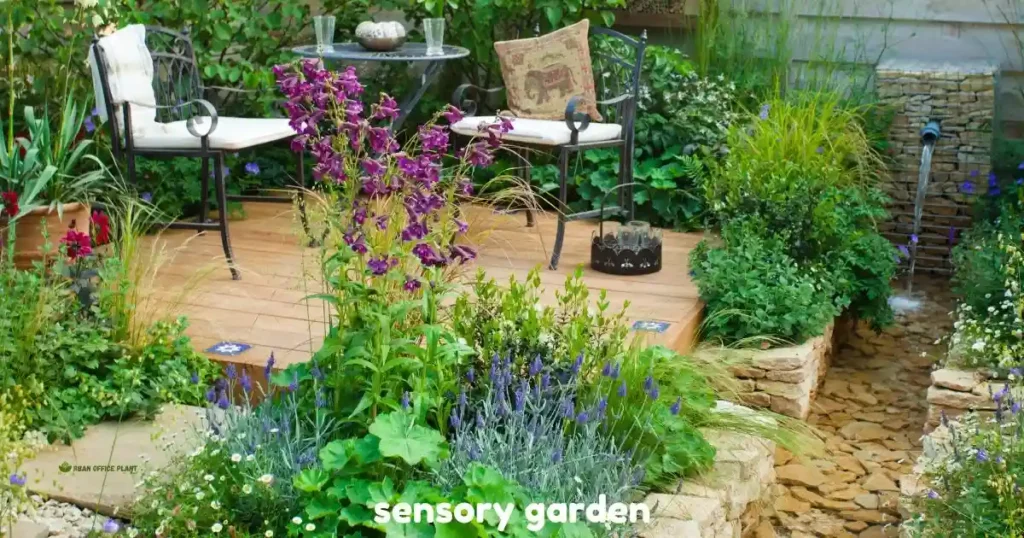Sensory Garden Design: A Complete Guide to Creating a Multi-Sensory Outdoor Space
A garden is more than just a collection of plants—it’s a place where nature and human experience connect. A sensory garden elevates this connection by engaging all five senses: sight, smell, touch, sound, and taste.
Whether you’re creating a therapeutic retreat, an educational space for children, or a peaceful backyard sanctuary, a sensory garden invites immersion, healing, and inspiration. This guide will walk you through the key principles of sensory garden design, the best plants for each sense, and creative, budget-friendly ideas to bring your sensory oasis to life.

What Is a Sensory Garden?
A sensory garden is an intentionally designed outdoor space that stimulates the senses through a curated mix of plants, textures, sounds, and interactive features.
These gardens are commonly used in:
Therapy settings (for autism, dementia, PTSD, sensory processing disorders)
Schools and community spaces for hands-on learning
Private homes for mindfulness and stress relief
Key Elements of a Sensory Garden
Visual Appeal: Use dynamic layouts, bold colors, and interesting plant forms.
Aromatic Scents: Integrate fragrant flowers and herbs.
Tactile Textures: Include soft, rough, fuzzy, or bumpy surfaces.
Soothing Sounds: Add water features, wind chimes, or rustling foliage.
Edible Delights: Grow herbs, fruits, and vegetables for interactive tasting.

Benefits of Sensory Gardens
Stimulates All Five Senses
Encourages interaction and presence in nature through multi-sensory input.Therapeutic Value
Reduces anxiety, encourages calm, and supports emotional healing.Enhances Learning
Offers experiential learning for children and adults alike.Inclusive Design
Creates accessible, safe, and enriching environments for people of all abilities.
Principles of Sensory Garden Design
1. Engage All Five Senses
Design sensory zones dedicated to each sense.
2. Create Exploration Zones
Use arches, hedges, or pathways to lead users through different experiences.
3. Ensure Accessibility
Include wide, level paths and raised beds for users of all ages and abilities.
4. Add Seasonal Interest
Choose plants that provide color, scent, or sound year-round.
5. Balance Calm and Stimulation
Create lively areas with vibrant flowers alongside quiet nooks with soft lighting and seating.

Best Plants for Each Sense
🌼 Sight
Bright flowers: Sunflowers, tulips, marigolds
Unique shapes: Succulents, alliums, ornamental grasses
Seasonal highlights: Japanese maple (fall), snowdrops (winter)
🌸 Smell
Fragrant herbs: Lavender, mint, rosemary
Aromatic flowers: Jasmine, honeysuckle, roses
Scented foliage: Lemon balm, eucalyptus
🤲 Touch
Soft textures: Lamb’s ear, moss, ferns
Rough/bumpy: Tree bark, ornamental grasses
Interactive: Mimosa pudica (sensitive plant)
🎵 Sound
Rustling plants: Bamboo, quaking aspen, tall grasses
Seed pods: Poppies, rattlebox
Wildlife attractors: Coneflowers and sunflowers (birds)
🍓 Taste
Fruits: Strawberries, raspberries, blueberries
Veggies: Cherry tomatoes, snap peas
Herbs: Basil, thyme, lemon balm

Sensory Garden Ideas for Children
Design a safe, educational space that’s fun to explore:
Interactive Features
Colorful stepping stones and winding paths
Water play (fountains or splash pads)
Fairy gardens or themed discovery zones
Sandboxes with tactile tools and hidden items
Safe Plants & Surfaces
Child-safe plants: Mint, sunflowers, strawberries
Soft surfaces: Grass, moss, cushioned mats
Paths: Slip-resistant textures like rubber tiles or bark chips

Features to Enhance the Experience
Water features: Ponds, birdbaths, or rain chains
Pathways: Stepping stones, wood chips, gravel for varied texture
Seating areas: Benches, hammocks, or swings
Lighting: Solar lights for evening ambiance
Sound elements: Wind chimes, rustling plants, or trickling water
Advanced Tips for Sensory Garden Success
Start Small: Begin with one sensory zone and grow over time.
Use Vertical Space: Trellises, hanging baskets, or living walls.
Encourage Wildlife: Add native plants, bird feeders, and butterfly attractors.
Use Natural Materials: Combine bark, pebbles, sand, and different plant textures.
Plan for Maintenance: Choose low-care plants and use mulch to reduce weeds.

Sensory Garden on a Budget
Upcycled Materials
Use pallets for raised beds
Turn old jars or tin cans into herb containers
Explore Now :
DIY Features
Build a water fountain with rocks and a small pump
Make wind chimes from bamboo, spoons, or shells
🛠️ Products Mentioned in This Guide:
- Textured Garden Stepping Stones– Create sensory-safe walkways with texture and style
- Scented Herb Starter Kit – Grow lavender, mint, rosemary, and more for aromatic gardens
- Child-Safe Garden Tools – Great for interactive sensory activities with kids
FAQ: Sensory Garden Design
What is a sensory garden?
A sensory garden is an outdoor space designed to engage the senses of sight, smell, touch, sound, and taste. It combines plants, textures, sounds, and features to create a stimulating and therapeutic environment.
What are the benefits of a sensory garden?
Sensory gardens promote relaxation, reduce stress, and enhance mental well-being. They’re also inclusive, providing accessible spaces for individuals with disabilities or sensory processing disorders.
What are the best plants for a sensory garden?
The best plants depend on the senses you want to engage. For example, lavender and roses for smell, lamb’s ear for touch, and strawberries for taste.
How do I design a sensory garden?
Start by dividing your garden into zones for each sense. Choose plants and features that stimulate sight, smell, touch, sound, and taste. Incorporate pathways, seating, and water features for added sensory appeal.
Can sensory gardens be used for therapy?
Yes, sensory gardens are often used in therapeutic settings to help individuals with autism, dementia, or mental health challenges. They provide a calming and engaging environment that promotes well-being.
A sensory garden is a harmonious blend of nature’s beauty and human interaction. By thoughtfully combining colors, textures, scents, sounds, and tastes, you can create a garden that stimulates the senses and soothes the soul. Whether for personal relaxation, education, or therapy, a sensory garden offers endless possibilities to reconnect with the natural world.
Start designing your sensory oasis today and experience the transformative power of nature at its finest.







